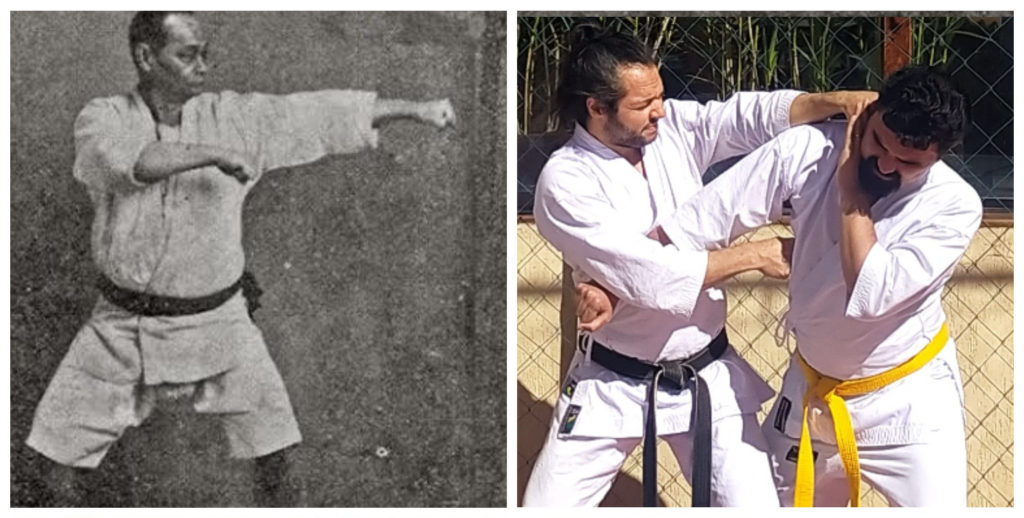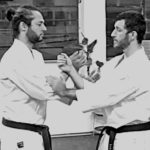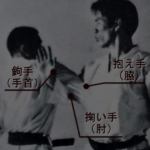On the top of this article is a famous picture where Okinawan karate master Chōki Motobu supposedly demonstrates an application for the final movement of Naihanchi Shodan kata. It has been widely shared as a correct application, but is that really the case? I don’t think so. Here is why:
- To begin with, is that application really meant for Naihanchi Shodan? Who attributed that correspondence? The side-by-side comparison looks like something someone made long ago and that has become widely accepted without questioning, but I raise the doubt of whether Motobu sensei really originally intended to show it as an application of the Naihanchi’s movement on the left.
- In any case, the body mechanics simply don’t match. In the kata, both arms move in the same direction (in what is often called a morote-zuki 諸手突き), while in the alleged “Motobu application” the rear arm moves in the opposite direction of the lead arm, pulling the opponent’s arm.
- It is ok to develop variations of applications that deviate from the original form and intent of the kata, but it’s important to understand that those are “derivative” applications, and that more direct applications have been originally envisioned. Those direct applications will naturally follow the form of the kata. Otherwise, why would the kata be performed one way and then be applied in a different way in the first place?
- There’s evidence1 that – as certainly happened to most practitioners of his generation2 – Chōki Motobu wasn’t extensively taught original/correct applications for the kata he learned. Instead, he was left to find out applications on his own. Having to find applications on your own may sound like standard karate experience nowadays, but it definitely wasn’t the case in the era of real old style karate (before the opening to the public), where the kata would be taught along with the explanation of the exact meaning of each movement.
With all that said, there are versions3 of a different kata – Jion – that end in a somewhat similar position, but with a motion where the rear arm is indeed pulled in the opposite direction of the lead arm. In this case, it seems reasonable to consider that the application shown by Motobu sensei would match Jion kata. But it requires further investigation (real bunkai is a process that follows rules and that cannot be done by simply by comparing pictures or even videos).
In any case, all the above doesn’t mean the applied maneuver shown by Motobu sensei isn’t good (it is great in fact). The point is simply that it doesn’t correspond to that specific kata movement in reality. It is also woth noting that there is no doubt that Motobu sensei was a formidable fighter – this is a historically indisputable fact.

In the picture above I show a hypothesis of application that I believe to be more fitting to the original motion of the kata. It’s an attack in two levels, where the opponent tends to focus on the defense of one level while receiving the blow in the other level. Below, I show the application in video, along with a more detailed analysis starting from the previous movement, so you can have a clearer idea of how it works. I’m open to respectful discussion on the topic. Feel free to chime in and say what you think!
Notes:
1 In the text “A Brief history of Motobu”, signed by Chojo Kanna, it is said: “Whenever he discovered a potential application concept during training, Motobu would virtually neglect eating or sleeping in order to have his query satisfied by visiting one of his many mentors.” [MCCARTHY, Patrick. Motobu Chōki’s 1932 “Watashi no Karate-jutsu” (2nd Edition). International Ryukyu Karate Research Group: 2006. p. 109]. This excerpt evidences the fact that, by the time Motobu was being instructed in karate, and regarding his own instruction, explanations of concepts of kata application were left up to the student to come up with, instead of being openly and sistematically given along with the kata training provided by the instructor.
2 In Motobu’s “Watashi no Karate-jutsu”, he says: “Matsumura clearly understood the distribution of strength and how kata was applied.” [MCCARTHY, Patrick. Motobu Chōki’s 1932 “Watashi no Karate-jutsu” (2nd Edition). International Ryukyu Karate Research Group: 2006. p. 88]. The fact that the author considered noteworthy the knowledge of Matsumura on kata application indicates that in the author’s generation such a knowledge was no longer common among karate practitioners.
3 One well-known example of a Jion version with the pulling motion of the rear hand is the one practiced in Shotokan. It can be seern in the video below:




